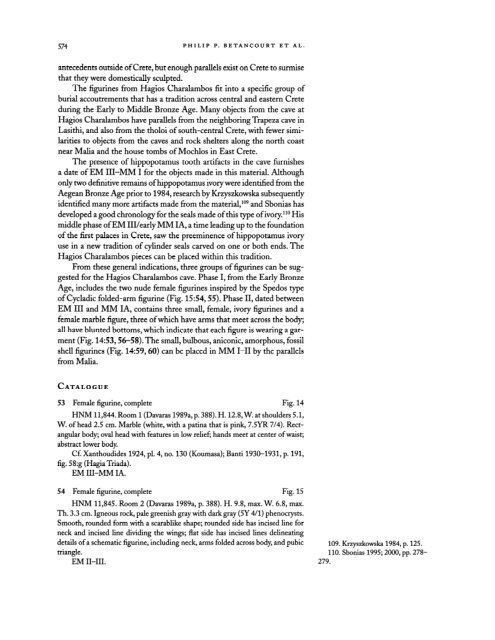Download - The American School of Classical Studies at Athens
Download - The American School of Classical Studies at Athens
Download - The American School of Classical Studies at Athens
You also want an ePaper? Increase the reach of your titles
YUMPU automatically turns print PDFs into web optimized ePapers that Google loves.
574<br />
PHILIP P. BETANCOURT ET AL.<br />
antecedents outside <strong>of</strong> Crete, but enough parallels exist on Crete to surmise<br />
th<strong>at</strong> they were domestically sculpted.<br />
<strong>The</strong> figurines from Hagios Charalambos fit into a specific group <strong>of</strong><br />
burial accoutrements th<strong>at</strong> has a tradition across central and eastern Crete<br />
during the Early to Middle Bronze Age. Many objects from the cave <strong>at</strong><br />
Hagios Charalambos have parallels from the neighboring Trapeza cave in<br />
Lasithi, and also from the tholoi <strong>of</strong> south-central Crete, with fewer similarities<br />
to objects from the caves and rock shelters along the north coast<br />
near Malia and the house tombs <strong>of</strong> Mochlos in East Crete.<br />
<strong>The</strong> presence <strong>of</strong> hippopotamus tooth artifacts in the cave furnishes<br />
a d<strong>at</strong>e <strong>of</strong> EM III-MM I for the objects made in this m<strong>at</strong>erial. Although<br />
only two definitive remains <strong>of</strong> hippopotamus ivory were identified from the<br />
Aegean Bronze Age prior to 1984, research by Krzyszkowska subsequently<br />
identified many more artifacts made from the m<strong>at</strong>erial,109 and Sbonias has<br />
developed a good chronology for the seals made <strong>of</strong> this type <strong>of</strong> ivory.110 His<br />
middle phase <strong>of</strong> EM Ill/early MM IA, a time leading up to the found<strong>at</strong>ion<br />
<strong>of</strong> the first palaces in Crete, saw the preeminence <strong>of</strong> hippopotamus ivory<br />
use in a new tradition <strong>of</strong> cylinder seals carved on one or both ends. <strong>The</strong><br />
Hagios Charalambos pieces can be placed within this tradition.<br />
From these general indic<strong>at</strong>ions, three groups <strong>of</strong> figurines can be suggested<br />
for the Hagios Charalambos cave. Phase I, from the Early Bronze<br />
Age, includes the two nude female figurines inspired by the Spedos type<br />
<strong>of</strong> Cycladic folded-arm figurine (Fig. 15:54, 55). Phase II, d<strong>at</strong>ed between<br />
EM III and MM IA, contains three small, female, ivory figurines and a<br />
female marble figure, three <strong>of</strong> which have arms th<strong>at</strong> meet across the body;<br />
all have blunted bottoms, which indic<strong>at</strong>e th<strong>at</strong> each figure is wearing a garment<br />
(Fig. 14:53, 56-58). <strong>The</strong> small, bulbous, aniconic, amorphous, fossil<br />
shell figurines (Fig. 14:59, 60) can be placed in MM I- II by the parallels<br />
from Malia.<br />
C<strong>at</strong>alogue<br />
53 Female figurine, complete Fig. 14<br />
HNM 11,844. Room 1 (Davaras 1989a, p. 388). H. 12.8, W. <strong>at</strong> shoulders 5.1,<br />
W. <strong>of</strong> head 2.5 cm. Marble (white, with a p<strong>at</strong>ina th<strong>at</strong> is pink, 7.5YR 7/4). Rectangular<br />
body; oval head with fe<strong>at</strong>ures in low relief; hands meet <strong>at</strong> center <strong>of</strong> waist;<br />
abstract lower body.<br />
Cf. Xanthoudides 1924, pl. 4, no. 130 (Koumasa); Banti 1930-1931, p. 191,<br />
fig. 58:g (HagiaTriada).<br />
EM III-MM IA.<br />
54 Female figurine, complete Fig. 15<br />
HNM 11,845. Room 2 (Davaras 1989a, p. 388). H. 9.8, max. W. 6.8, max.<br />
Th. 3.3 cm. Igneous rock, pale greenish gray with dark gray (5Y 4/1) phenocrysts.<br />
Smooth, rounded form with a scarablike shape; rounded side has incised line for<br />
neck and incised line dividing the wings; fl<strong>at</strong> side has incised lines deline<strong>at</strong>ing<br />
details <strong>of</strong> a schem<strong>at</strong>ic figurine, including neck, arms folded across body, and pubic<br />
triangle.<br />
EM II- III.<br />
109. Krzyszkowska<br />
1984, p. 125.<br />
110. Sbonias 1995; 2000, pp. 278-<br />
279.
















